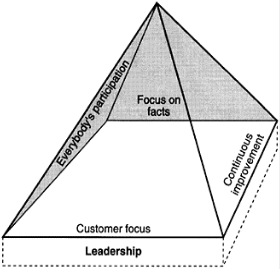The Foundation And The Four Sides Of The Tqm Pyramid
Introduction:
The Quality Journey tears down outdated management pyramids, arguing instead for the need to build a whole new management pyramid one which can live up to the vision and challenges inherent in the definition of TQM. Management at all levels and in all departments just could not see that ‘total quality’ can only be achieved with the active participation of management. An apt name for this pyramid would be the TQM pyramid.
Principles of TQM:
TQM is characterized by five principles:
1. Management’s commitment (leadership);
2. Focus on the customer and the employee;
3. Focus on facts;
4. Continuous improvements (KAIZEN);
5. Everybody’s participation.
MANAGEMENT’S COMMITMENT:
- Management at all levels and in all departments just could not see that ‘total quality’ can only be achieved with the active participation of management.
- A vital task for any management is to outline quality goals, quality policies and quality plans in accordance with the four sides of the TQM pyramid.
-
This is extremely important so important in fact that, in many firms, top management (the board of directors) ought to review the firm’s quality goals and policies and if necessary reformulate them so that they conform to the four sides of the TQM pyramid.

- The firm’s quality goals give all employees a clear indication of what is going to be achieved concerning quality. The firm’s quality policies, on the other hand, describe in more detail how employees are to achieve that goal. The firm’s quality policies must also conform to the four sides of the TQM pyramid.
- Quality goals and quality policies must be followed by meaningful action plans. Experience from firms which have understood and realized the TQM vision shows thatfirms ought to concentrate on short-term plans (one-year plans) and long-term plans, thelatter often being three-year plans which are revised annually in connection with anannual quality audit.
Deming’s seven principles:
1. Management must agree about goals, conditions and obstacles to the introduction of TQM.
2. Management must have the courage to break with tradition.
Fig:Management’s commitment (leadership)
3. In building up a new ‘quality organization’, management must appoint a manager for quality improvements who has direct access to top management.
4. Management must, as quickly as possible, build up an organization to advise on the carrying out of continuous improvements throughout the firm.
5. Management must explain to employees why changes are necessary and that they will involve everybody in the company.
6. Management must explain that every activity and every job has its own customers and suppliers.
7. Management must ensure that every employee in the company participates actively in a team (work team, quality circle).
The above points implicitly include all four sides of the TQM pyramid.